BOOK EARLY! Save More
Early Bookings Save Up to 40%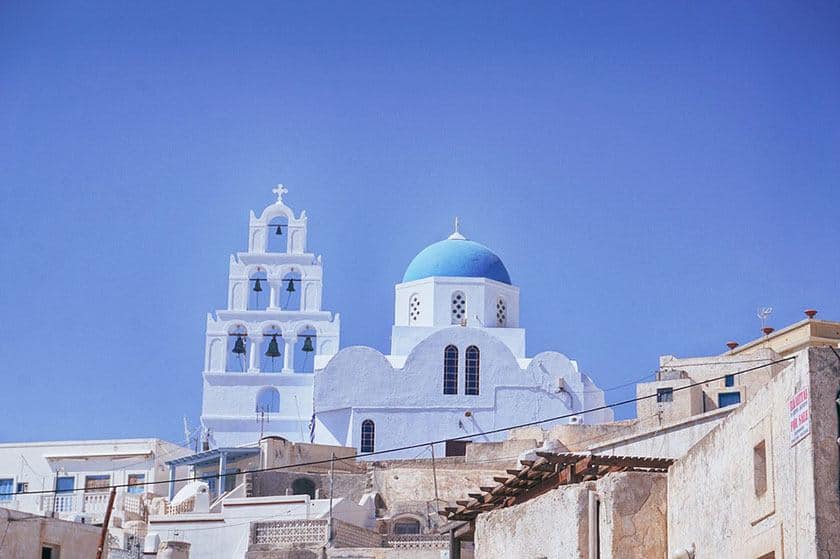
There are so many things you can do on the beautiful island of Santorini, apart from being on one of its enchanting beaches. The top 25 Santorini Attractions and sightseeing places include: Villages, museums, wineries, churches, monasteries, and many other places are on the list of the best sights we have prepared, suggesting a visit to those who come to Santorini.
Nea Kameni (formerly known as Nea Kaimeni), the “volcano”, as the locals call it, is a volcanic island in the center of the Santorini caldera, which began to be created around 1570, initially creating Mikri Kameni and is the most recently created land section in the Mediterranean Sea. The area of today is 340 hectares and its highest point is 127 meters above sea level. There are two anchorages on the island, Taxiarchis bay, on the southeastern side of the island, and Erinia bay to the north.
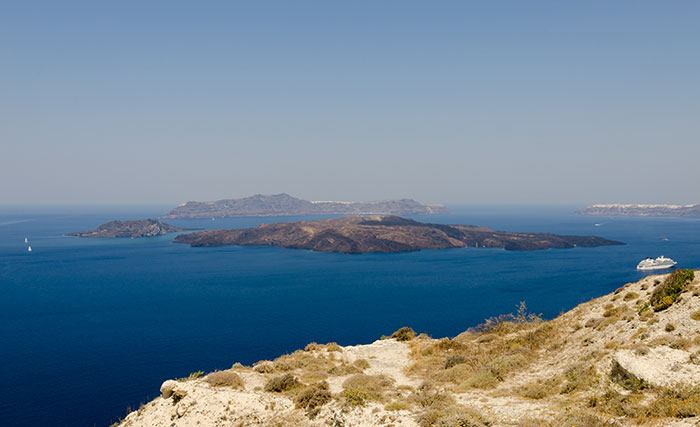
Palaia Kameni (formerly known as Old Kaimeni) is a small volcanic island in the center of the Santorini caldera, which began to form with a volcanic eruption between 46-47 AD, initially creating the island of Thea. The area of today is 0.525 km2 and its highest point is about 98 meters from the sea. Several hot springs are along the coast, and during the summer a large number of tourists visit the island to swim in the yellow – from the sulfur – water. The main hot spring of the island is located in the bay of Agios Nikolaos.
The terrible Minoan eruption, 3600 years ago, precipitated the volcano of Strongyles and created today’s caldera, leaving a circular shape of the islands, Thira, Thirassia, and Aspronissi, above the sea. After the creation of the Caldera Magma, it began to pour into the sea by building a volcanic mountain that will form the foundations of Nea and Palaia Kameni.
Santorini’s active volcano is one of the most popular Santorini Attractions and continues to go through a calm phase, following the signs of mobility it had given in 2011-2012.
The volcano of Santorini is one of the largest underwater active volcanoes in the world. Perhaps the only volcano that Caldera reaches the sea. Its biggest explosion occurred during the Minoan Bronze Age 3,600 years ago. The entire center of the circular island sank into the sea during the terrible volcanic eruption. The explosion caused a tidal wave that wiped out the advanced civilization of Minoan Crete, 70 miles south of Santorini.
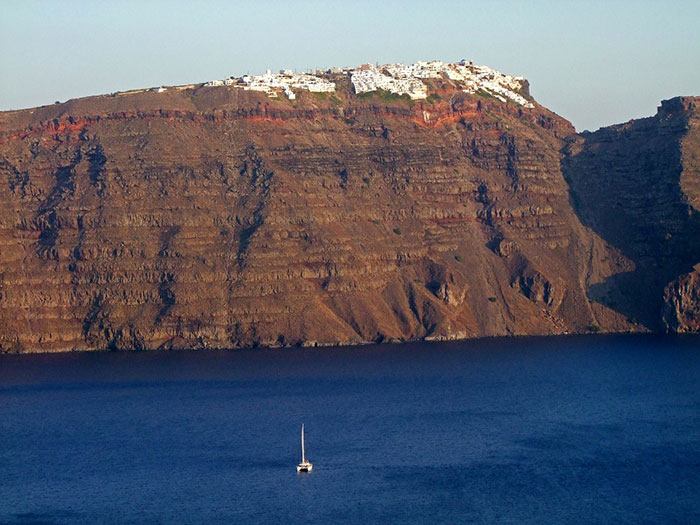
The eruptions of the volcano sank the central part of the island, while other parts of the island were cut off. What draws all eyes now is the famous Caldera of Santorini, the only inhabited marine Caldera in the world with a diameter of 10 kilometers and a height of about 300 meters.
The volcano of Santorini has created a fascinating landscape and a unique ecosystem in which the vineyard of Santorini, whose history is ancient and comes from prehistoric times, has been adapted in the best way.
Also known as Wine Roads a very famous Santorini attraction, with many tours and excursions, you will be able to experience the wine-making tradition of Santorini and can satisfy even the most discerning wine friends. Visit the island’s wineries and enjoy the tasty to get to know the different local wine types. You will visit vineyards with centuries of history, and the hospitable winegrowers of Santorini will invite you to the fine wine of the island, as well as the ritual of turning grapes into wine!
Santorini has 16 wineries, of which you can visit the 13, while in 11 of them there are facilities for access to people with special needs. The island’s wineries are visited by 700,000 visitors each year. Taking into account that Santorini receives around 2 million visitors each year, then one in three visitors opts to visit the wineries, which is a unique experience. Visitors from Europe, and wine-producing countries such as France, Spain, and Italy, but also from the US and China. Some wineries in Santorini have wedding rooms, while several wine conferences are held. The first organized wine tourism tour of Santorini took place only in 2010 and has since become indifferent to the visitors of the island!
The Archaeological Museum of Thira is located in the center of Fira as one of the most popular Santorini Attractions in the capital of Santorini and reveals the long history of the island. The building where it was housed was built in 1960 by the Ministry of Public Works to replace the precedent that collapsed in the 1956 earthquake. In its rooms, there are collections of sculptures and inscriptions from the Archaic to the Roman period as well as ceramic vases and clay statuettes from the Hellenistic period.
Collections including:
The most important exhibits are the theatrical amphora with geometric decoration dating back to the beginning of the 7th century BC, the great volcanic stone (trachitis) weighing 480 kilos, as well as many finds from the excavations at the cemetery of ancient Thira, such as amphoras, ceramic objects, and statues.
The folk tradition of Santorini is kept alive in Fira’s Kontohori, in a cave-house that was built about a century and a half ago. Where today is the Folklore Museum of the island, which the traveler deserves to visit.
The museum is housed in a series of traditional underground buildings of Santorini – some of which have a life of more than 150 years – that were renovated for the needs of the museum in 1973, while in 1993 new buildings were built for the new wings of the museum and a chapel devoted to Agios Konstantinos in memory of the former owner of the estate Konstantinos Lignos, who was the uncle of the founder of the museum. It is one of the top Santorini Attractions in Fira. There is a dump with wine press, linen, barrels, and old utensils, while layers of deposits from volcanic eruptions are evident.
Perhaps one of the lesser-known Santorini Attractions, the Monastery of the Dominican Sisters, is located in Firostefani, there is a Catholic monastery dedicated to Saint Catherine which consists of sisters of the Dominican domination. Indeed, a few years ago, he celebrated his 400 years of presence in the heart of the Aegean Sea! It was founded in 1596 by Dominican Bishop of Catholic Thira, Antonios De – Marky. It was located within Kasteli of Skaros and was built in a rock. At this time the community consists of Sisters of different nationalities, a symbol of the universal Church and the reconciliation of all around Christ.
The Gyzi Megaron, one of the few old 17th-century mansions that survived the earthquakes of 1956, was granted by the Catholic Diocese of Thira for the activities of the Spiritual Center. At the entrance of the Megaron, he presents the coat of arms of the Gyzi family. Gyzi Megaron is the only building of that time in Santorini, and this makes it one of the most important Santorini Attractions, with a special architecture thanks to the interior patio that is created, which is partly covered with a magnificent quadrangle and partially obscured.
You will see collections of original engravings, paintings on Santorini, paintings donated by Leon Pindos, old photographs and stones of Santorini.
Cultural events such as paintings, theatrical performances, musical evenings, etc. are taking place here.
There is also a permanent exhibition with old maps and documents related to Santorini and the rest of the Cyclades.
If you are fascinated by the uniqueness of natural landscapes, then Santorini is the destination of your next vacation! Check out the mysterious and stunning Caldera beauty. Let your eyes wander around the unbeatable views of the volcanic islands and overlook the enchanting sunset, a spectacle that generates the strongest feelings.
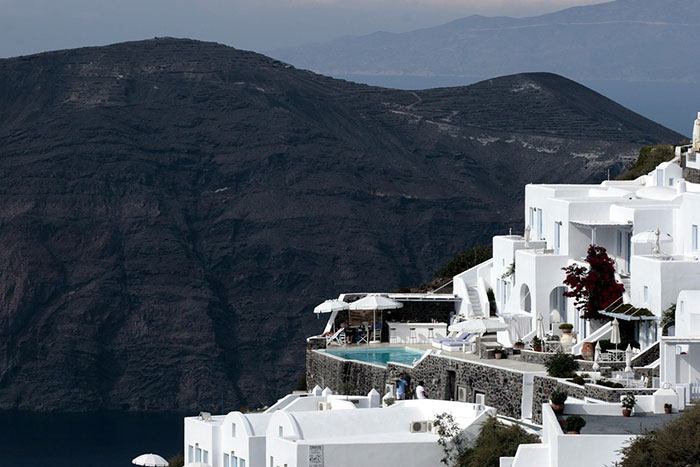
The caldera of Santorini is a large, mostly sunken caldera, located in the southern Aegean Sea, 120 km north of Crete. Visible above the water are the islands of Thira, Thirasia and Aspronissi perimetrically and in the center of the islands of Nea and Palaia Kameni.
With its story striding between myth and reality, the Caldera was said to hide the secret of Missing Atlantis and was explored by Cousteau, one of the most important explorers and filmmakers of our time. The identification of the Missing Atlantis with the sunken part of Santorini has never been confirmed.
Akrotiri is a village of Santorini with 450 inhabitants, based on the 2001 census. It is located at the southwestern tip of the island, 15 km from Fira, the capital of Santorini. Administratively, it belongs to the local Akrotiri apartment of the Municipality of Thira. During the medieval times (Venetian conquest) it was one of the island’s chests. Today, at the top of the hill over which the modern village is built, there is still the Venetian Tower (Goulas), the old one, that is, the castle. It became known worldwide thanks to the prehistoric settlement discovered in the excavations, which Spyros Marinatos began systematically in the region in 1967.
Since then, Akrotiri can be considered as an ongoing excavation project, a must-visit to anyone that interested to discover the prehistory of the island and of course one of the worth visiting Santorini Attractions, in 2017 50 years have been completed since the beginning of the works and it is estimated that only 26% of the settlement’s area has been excavated to the foundations.
Responsible for the gradual decline and final fall of the Minoan Empire, was the terrible eruption of the volcano of Santorini. Often the documentation of these claims is used as an example of the Krakatoa explosion in Indonesia (August 7, 1883), which is referred to as the largest volcanic eruption in modern times, while the volcanic eruption of Thera was fourfold.
During medieval times and the Venetian occupation, Akrotiri was one of the five castles (“Kasteli”) on the island. It was built around 1335 and one year later it was given to the Gozzadini family by Naxos Duke Nikolaos Sanoudos. It was called Punta Cassel or La Ponta, which in medieval Italian means “top” but also “cape”. In the middle of the settlement was the “Goulas” (tower) of Akrotiri, which was in very good condition until the earthquake of 1956 when it suffered serious damage.
The Gozzadini came from Bologna. The strong defensive position of the castle allowed Gozzadini to have it in their possession for a long time, even in the first decades of occupation of Santorini by the Turks, whose hands eventually fell in 1617 (while the rest of the island was occupied by in 1566). In Kasteli and Akrotiri Goula, go afternoon to the evening, especially when it has music evenings.
Emborio or Nimporios is the largest village of Santorini with 1773 inhabitants according to the 2001 census. It is located on the southern side of the island, 12 kilometers from Fira, at the foot of Mount Profitis Ilias.
From the village’s characteristics and one of lesser-known Santorini Attractions is the tower of Goulas (Turkish rule: “tower”), a square tower in the northern part of the village, which was built during the period of Venetian domination, probably around the 15th century. The tradition is that the tower was built by the monks of the Monastery of St. John the Theologian of Patmos and that the treasures of the monastery were kept there. His use as a monk by the monks of this monastery was made quite late after his construction, while sources say that before the monastery he belonged to the Darzenta family. Inside the tower, there was a chapel, which no longer exists, of Osios Christodoulos, who was the founder of the Monastery of Patmos. From the tower, there was a tunnel, which led to the castle.
Near the tower of Goulas, there is the hill of Gavrilos or formerly Platanimos mountain, where there are eight traditional windmills of the 19th century and Byzantine ruins. The windmills have been designated as historic and preserved buildings and six of them have been granted today to the Municipality of Thira. According to a study prepared on behalf of the municipality, in the future, the two are expected to work as regular windmills, one as a museum for windmills and mill tools, one as a traditional café, and the rest as traditional product shops.
The hill of Gavrilos is low south of Emporio. The mills of Santorini, one of the most photographed Santorini attractions, were made of volcanic stones, water, dirt, and lime, and their height was about six meters. At the end of the ridge, at the top of the hill, we will meet the white chapel of Profitis Ilias Chamilos (unlike the homonymous Holy Monastery located at the highest point of the island).
A three-aisled monastery since it has a chapel dedicated to Agios Panteleimon, one at Zoodochos Pigi, and the center dedicated to Agios Nikolaos. The monastery was founded in 1651 in the sculpture of Skaros, where it was a female monastery, until 1815 when the new monastery was built in its present location. At your visit, you will be able to admire the wood-carved iconostasis and the icon of Agios Nikolaos from the Byzantine years.
The Gyzi family, one of the few Orthodox families staying in Kastelli, had a privately-owned temple, built-in Skaros, dedicated to the memory of Agios Nikolaos, which, with the permission of the Archbishop of Santorini, decided to convert to a women’s monastery. The first sisters were the girls of the Gyzi family.
Skaros was the oldest and probably the most important of the five fortified settlements of Santorini. It is also the only one from which almost nothing is saved.
Skaros’ Kastelli guarded the western entrance of the island and was not conquered once during his 600 years of life. The castle overlooking the rock of Skaros has a long history and deserves a visit, naturally on foot, following the path that connects the cliff with Imerovigli (about 20 minutes walk). Do not miss visiting the small chapel at the front of Skaros, visible from the boat when entering the caldera.
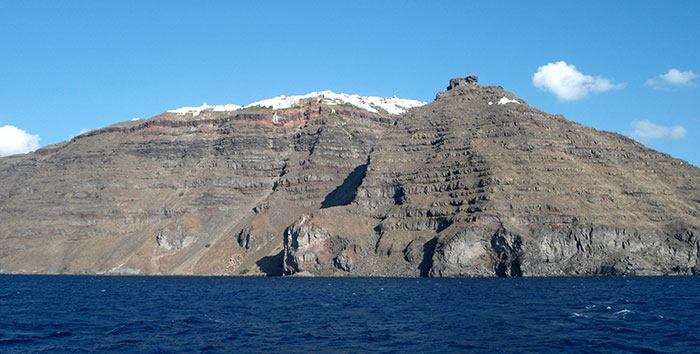
In Skaros there was the oldest castle (Upper Castle or Rocka) and the subsequent downstairs castle that suffered from the fall of the rocks. The oldest castle was built in Byzantine times, by Venetian Jacomo Barocci, to whom Santorini was granted in 1207. He and his nobles used it as a home and residence.
Ancient Thira is located in Mesa Vouno, at an altitude of 396 m. It was founded in the 9th century BC. by Dorian settlers, led by Thira, and inhabited until the early Byzantine times.
Excavations have revealed mainly the Hellenistic and Roman phases of the city.
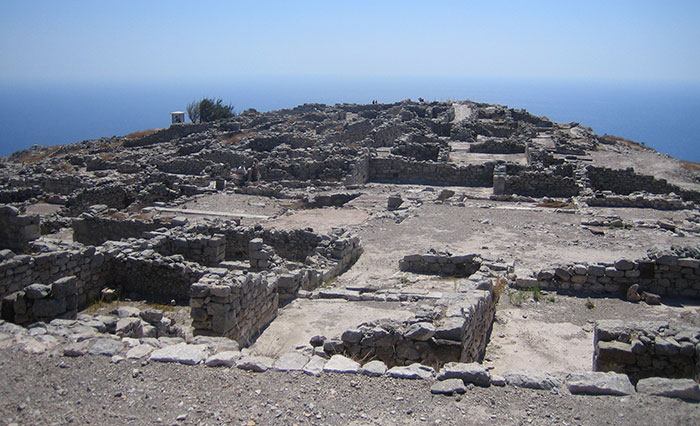
After the destruction of Akrotiri, Thira remained uninhabited, with few exceptions, until the 8th century BC. Then Dorian settlers arrived from Sparta, headed by Thiras, from where the island was named. On the western side of the peak of Mesa Vouno was built the city, the urban center that controlled the whole island. The city was left without a wall due to its natural fortified position and was connected by road with its two ports, Oia (today Kamari) and Elefsina (today Perissa). There are few things left in the early phase of the city.
After the 4th century BC, the city is growing, it is in the sphere of influence of the Ptolemies, the Greek monarchs of the Kingdom of Egypt, and then, like all of Greece, it is settled by the Romans. The city declined after the 3rd century AD and after the 9th century is abandoned. Since 1896, its excavation has begun by German and Greek archaeologists.
During the Middle Ages, Oia was one of the island’s “Kasteli”: Kastelli of Agios Nikolaos.
There are reports of the castle’s existence in 1480. However, Oia suffered great damage from the 1956 earthquake, and much of the traditional settlement fell to the sea beneath the caldera. Large churches, such as the church of Agios Georgios and Panagia Platsani, were destroyed.
Today, Agios Nikolaos’ Kastelli in Oia, a piece of the tower is preserved and it is a Santorini attraction. It was named after a subculture church dedicated to Agios Nikolaos and was built around 1450.
Characteristic in the Cyclades, windmills were the main means of producing flour. In the Cyclades, almost everywhere they are included in the sights of the islands, and of course, they are one of the sights of Santorini.
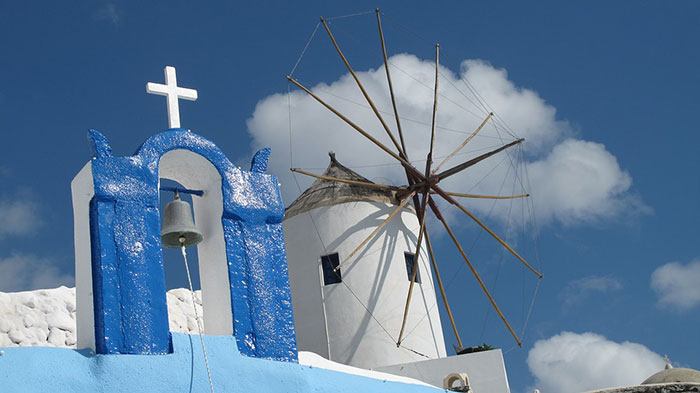
In a few windmills, an inscription is preserved concerning the year of their construction, but family and community traditions are sometimes still alive and fresh memories are associated with the construction and history of these particular buildings. The main sources of data for them are community records and references to them in the flood-control operations that regulate hereditary and topographical issues of windmills, community decisions on the equitable application, as well as decisions of political or ecclesiastical courts related to various frictions and conflicts during their operation.
According to the architect Stefanos Nomikos for the appearance of the windmills on the island, we can deduce, based on the example of the closest Aegean islands, that they were operating from the 14th century. They mainly ground barley and less wheat, at times, and beans.
The traces of the maritime history of the island were undertaken in 1951 by Captain Antonis Dakoronias and in 1956 the Maritime Museum was founded in Oia. Since 1990 he has been housed in a nice 19th-century captain’s house, donated by Dina Manolessos-Birbilis. It includes all kinds of exhibits that relate to the history of shipping on the island, mainly during the 19th century.
A museum that has been effortlessly and lovingly built by people who have faithfully served the sea for many years. The treasures of the Maritime Museum of Thira are rare examples of the maritime tradition of Santorini and one of the best Santorini attractions since they have been found in old captains of the island.
The sailors, the captains, and the crews of Santorini unloaded their cargo and returned bringing all sorts of precious commodities, but most importantly returned bringing experiences and wealth to the island. Even sometimes he returned by bringing products such as the anhydrous tomato found in the microclimate of Santorini the ideal conditions to develop and created for many decades a new cycle of commercial development and prosperity with Santorini tomato-type tomatoes for the island and its inhabitants.
In a cavity on the slope of the Mesa Vouno, some 200 meters from its foothills, is the church of the Panagia Katephiani dating back to 1537 – 1650 AD. Its name comes from the word “katefio” which means shelter because there the inhabitants were going to protect themselves from hostile raids. In Panagia Katephiani, many residents were also tempted by the bad weather, the volcanic eruption of 1650, that is, the Kolumbo submarine volcano.
Apart from various local feasts in Perissa, a great celebration is also held at Panagia Katefiani (1537-1650). Behind the temple is a cool cave, and the view from this place is more than amazing.
We approach the church, following path (three) (connecting Perissa with Kamari after passing through Ancient Thira, at the top of the Mesa Vouno). We will turn right where we will see a cross nailed on a rock. The vertical rocks of the Mesa Vouno are also used as a climbing field (Perissa climbing field).
In Perissa, a beautiful temple of the 5th century AD, Agia Irini, also known as Santa Irene of Santorini, is projected through the earth, revealing the history of the island. For years, the view prevailed that the reason that the Venetians called the island “Santorini” was the existence of a small church of Agia Irini in Thirasia. This would, of course, be odd, as the Venetian seamen could not fail to understand that Thirasia and Santorini are two different islands.
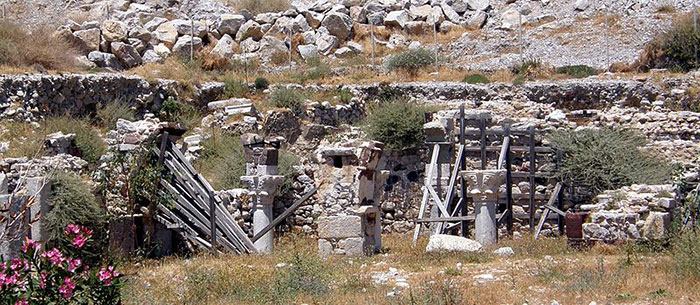
In 1992, when the Second Ephoria of Byzantine Antiquities began the work of laying in the middle of the Byzantine (8th to 9th century) church of Agia Eirini, which was at the foot of the Mesa Vouno. Under this temple was discovered the ruins of the Early Christian Basilica of Agia Eirini, whose construction dates back to the end of the 5th century, and there appeared to have been a second building phase in the second half of the 6th century. It was a three-aisled basilica with a mean aisle length of 25 meters. The east part of the middle aisle of the Early Christian temple had been used to build the Middle Byzantine.
The Patriarchal Monastery of Profitis Ilias is located at the top of the homonymous mountain, at 567 m altitudes with great views of the island and is 3 km from the Pyrgos.
The monastery was built by the hieromonks brothers Gabriel and Ioachim, who originated in the village in 1711 when the abbey was established, although the final-present form of the monastery was given in the 19th century.
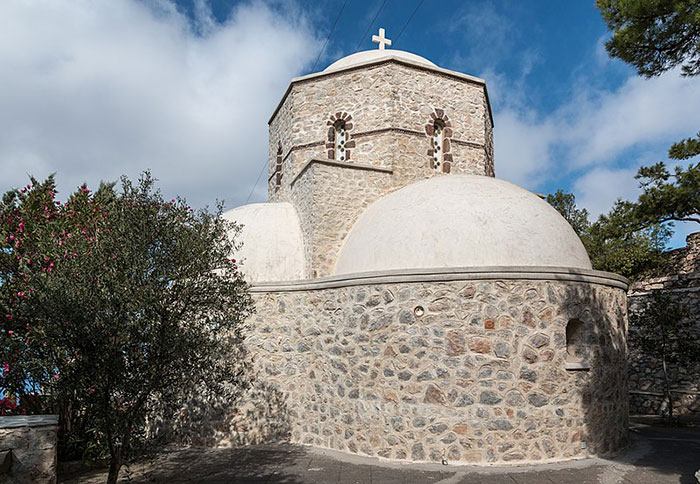
As evidenced by the literary documents and the titles the Profitis Ilias initially lived in Constantinos Pragiotis, later came to Parthenios Sigalas, a relative of the deceivers, who devised the second chapel of the Apostate. Parthenios Sigalas gave to his brothers Gabriel and Ioachim.
Agia Triada, formerly a katholikon of a small women’s monastery and today houses the collection, was also destroyed in the early ’70s. Only the northern wall and part of the sanctuary survived. The church remained closed until 1997 when, at the initiative of the president of the community, the community council, and the Metropolis of Thira, the church was opened and continues to function as an ecclesiastical museum and became one of religious Santorini attractions.
The collection includes icons of Cretan and local hagiographers, woodcarving and metalwork, ceramics, ecclesiastical embroidery, and other objects of ecclesiastical use, dating back to the 17th and 18th centuries, a time of prosperity and financial prosperity of Pyrgos.
The Argyros Mansion in Mesaria is one of Santorini’s top sights. The most elegant witness of the 18th and 19th centuries, which best reflects his time. Long before Santorini conquered the hearts of its visitors with its unique beauty, its wines were famous all over the world and the Argyros family played an important role in winemaking and their export. In the Mansion of the family, today’s visitor enjoys a tour of the everyday life of the 19th century, but he also listens to the beating of the heart of the powerful winegrowers and merchants of Santorini.
The building suffered serious damage during the 1956 earthquake and was fully restored after sponsorship by the Greek Ministry of Culture. In 1985, it was described as an “artwork” with 50 meters of protection area perimeter of ownership. In 1997 he was awarded the Europa Nostra Prize as a monument preserving our cultural heritage.
Georgios Emmanuel Argyros was a landowner and wine merchant. The mansion was built in 1888 on a pre-existing ground-floor traditional residence of 1860. The ground floor functions as a first-class guesthouse while the floor as a museum.
Art Space in Exo Gonia of Santorini began its operation in 1999 and continues its art activity to this day, hosting works by important Greek and foreign artists.
The building in Exo Gonia, Santorini, survived the 1956 earthquake and continues to withstand the commercialization of everything. Built with the craftsmanship imposed by the necessity and the art that dictated the taste of the old Santorini masons, the old Winery pits on the gloomy and dry volcanic land and breathes with its few valuable precious fruits. The wine presses, the whites of the must the high-rise vaulted canava are not stationary guards of the past, but tools alive and ready to offer to the Art of Wine.
Every year, loads of Asyrtikon, Mavrotragano, Atheri, and Vudomato, pass through the doors of the warehouse in wicker baskets to give the most valuable, perhaps, good of the sharp, stone of Santorini: wine. That’s why, Art Space is not just trying to preserve historical memory, it’s fighting to keep it alive and thriving. Each year, the fragrant must after fermenting turns into the dry, fragrant “Nychteri”. Another quantity of grapes spreads for two weeks under the indistinct sun of August and his must is transferred to wooden barrels for aging to give the valuable Visanto after many years. In 1999, Art Space was ready to open on its new road.
Antonios N. Argyros renovated the rooms respecting their original form and made the Art Space a unique Santorini attraction in Exo Gonia. He set up the Winery and begin the journey of Art … Over 250 leading Greek and foreign artists trusted their works and the cave spaces flooded with color and artistic figures. What was charming as an idea has become a seductive reality and thousands of visitors have gone through the heavy doors to see a Santorini that does not rest in the glory of its unique beauty, nor is it complacent to the indulgence of its past. A Santorini inspiring artists, but also hosting Art in all its manifestations.
After 19 years of continuous effort, the Volcan Wines winery of Georgios Koutsogiannopoulos, in Vothonas, Santorini, has created the only natural underground wine museum in Greece. It is at a depth of 6 meters below the surface of the earth, the museum has a total length of more than 300 meters, with corridors and labyrinth-shaped rooms. With exhibits dating from 1660 to 1970 and decoration that refers to the 17th – 18th century, the history of wine and the life of the Santorini viticulturist are presented in representations with a movable and immobile dummy.
For the creation of the wine museum, it took 21 years of hard work with patience and perseverance. The funding was entirely made by the Koutsogiannopoulos family. The visitor walks around the place watching replicas of the history of wine. An Automatic Audio Tour is available in 14 languages. Also available in a book in eight other languages.
Volcan wines have been awarded many times internationally and locally.